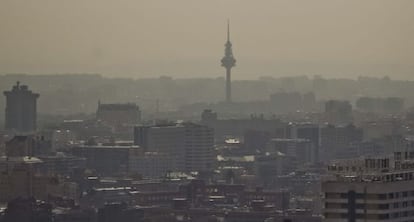An atmosphere fit for the Olympics?
Madrid 2020 bid says it is complying with pollution controls NO2 levels in the city frequently surpass EU limits

Madrid 2020, the capital’s Olympic bid project, claims to comply with “all the pollution control levels established by legislation currently in effect in Spain and the European Union.”
But this is not true. The city’s nitrogen dioxide NO2 — particles emitted mostly by motor vehicle exhausts, particularly from diesel engines — routinely surpass European Union limits. In January, the 24 stations scattered across Madrid recorded an NO2 average of 59 micrograms per cubic meter, higher than the annual European limit of 40.
At the request of the International Olympic Committee (IOC), the candidacy revealed air pollution levels in Madrid, Barcelona, Córdoba, Málaga, Valencia, Valladolid and Zaragoza. These numbers show that Madrid should ask for a five-year moratorium in order to comply with the target levels, but so far has not done so.
What Madrid has done instead is to pass an air quality plan that aims to bring emission levels down within EU bounds in that space of time.
The city is also promising to have all public transport running on clean energy by 2020 — a promise already made in 2008 by then-mayor Alberto Ruiz-Gallardón and his environment commissioner, Ana Botella. Since then, Botella has become mayor after Gallardón was tapped on the shoulder by the new central government and asked to become justice minister.
But Botella’s past environmental record has been a matter of public debate for years. The wife of former conservative prime minister José María Aznar had her first dispute with the environmentalists in early 2008, when she blamed “the African dust” for pollution in the city, apparently forgetting that 80 percent of the city’s pollution comes from NO2 from vehicle exhausts, not the Sahara desert. Environmentalists called her “ignorant” and she was even rebuked by the environment minister.
Years ago, the city’s website offered a pollution forecast that let people know whether air quality the next day would be reasonable. The forecast was made by an expert team from the Polytechnic University, and it remained in place for years.
That information is no longer available. Also, in late 2007 EL PAÍS revealed the city had been reporting admissible NO2 levels when the university model was in fact predicting very high levels. At the time, some measurement stations were recording 400 micrograms per cubic meter, while the website held that levels were pretty good. Two years later, Madrid dropped the university’s mathematical model and replaced it with a new system called Serena that experts consulted by EL PAÍS described as “very simple,” purely statistical and unable to work correctly in Madrid or elsewhere in Spain because of its high error rate.
The opposition Socialist Party will ask for a special plenary council session on environmental issues over the next few months, with a focus on the fight against pollution.
“The smog is there,” said the Socialist spokesman in the city council. “It is still a very real problem that is not being addressed in any way.”
Tu suscripción se está usando en otro dispositivo
¿Quieres añadir otro usuario a tu suscripción?
Si continúas leyendo en este dispositivo, no se podrá leer en el otro.
FlechaTu suscripción se está usando en otro dispositivo y solo puedes acceder a EL PAÍS desde un dispositivo a la vez.
Si quieres compartir tu cuenta, cambia tu suscripción a la modalidad Premium, así podrás añadir otro usuario. Cada uno accederá con su propia cuenta de email, lo que os permitirá personalizar vuestra experiencia en EL PAÍS.
¿Tienes una suscripción de empresa? Accede aquí para contratar más cuentas.
En el caso de no saber quién está usando tu cuenta, te recomendamos cambiar tu contraseña aquí.
Si decides continuar compartiendo tu cuenta, este mensaje se mostrará en tu dispositivo y en el de la otra persona que está usando tu cuenta de forma indefinida, afectando a tu experiencia de lectura. Puedes consultar aquí los términos y condiciones de la suscripción digital.








































